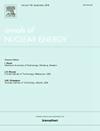Development of a start-up core for sustaining rotational fuel shuffling strategy for a nitride fueled lead-cooled fast reactor
IF 2.3
3区 工程技术
Q1 NUCLEAR SCIENCE & TECHNOLOGY
引用次数: 0
Abstract
This study investigates a start-up core design for a lead-cooled fast reactor employing a Rotational Fuel-shuffling Breed-and-Burn (RFBB) strategy using High-Assay Low-Enriched Uranium (HALEU) nitride fuel. Based on the Westinghouse Lead-cooled Fast Reactor, the reactor can achieve and maintain criticality using natural uranium as feed fuel for a refueling interval of 1050 EFPD. Analysis indicates an equilibrium discharge burnup of . The refueling strategy gradually replaces HALEU fuel with natural uranium assemblies, ensuring stable power profiles during the transition cycles. The reactivity control system can insert at least negative reactivity. Thermohydraulic assessments confirm effective heat removal, with peak fuel temperatures within operational limits. The study addresses proliferation risks from weapons-grade plutonium generation by proposing strategies for fuel reutilization and fuel assembly optimization. The study confirms the feasibility of the start-up core to sustain the RFBB mode while suggesting the potential for further optimization to control excess reactivity and enhance proliferation resistance.
氮化燃料铅冷快堆维持旋转燃料变换策略启动堆芯的研制
本研究采用高含量低浓缩铀(HALEU)氮化燃料,采用旋转燃料洗牌再生燃烧(RFBB)策略,对铅冷快堆启动堆芯设计进行了研究。该反应堆以西屋公司的铅冷快堆为基础,使用天然铀作为燃料,在1050 EFPD的换料间隔内可以达到并保持临界状态。分析表明,平衡放电燃耗为~ 230MWd/kgHM。换料策略逐渐用天然铀组件取代高浓铀燃料,确保在过渡周期中稳定的功率分布。反应性控制系统可以插入至少~ 15美元的负反应性。热水力评估证实了有效的散热,峰值燃料温度在操作范围内。该研究通过提出燃料再利用和燃料组件优化战略,解决了武器级钚产生的扩散风险。该研究证实了启动堆芯维持RFBB模式的可行性,同时提出了进一步优化以控制过度反应性和增强抗扩散能力的潜力。
本文章由计算机程序翻译,如有差异,请以英文原文为准。
求助全文
约1分钟内获得全文
求助全文
来源期刊

Annals of Nuclear Energy
工程技术-核科学技术
CiteScore
4.30
自引率
21.10%
发文量
632
审稿时长
7.3 months
期刊介绍:
Annals of Nuclear Energy provides an international medium for the communication of original research, ideas and developments in all areas of the field of nuclear energy science and technology. Its scope embraces nuclear fuel reserves, fuel cycles and cost, materials, processing, system and component technology (fission only), design and optimization, direct conversion of nuclear energy sources, environmental control, reactor physics, heat transfer and fluid dynamics, structural analysis, fuel management, future developments, nuclear fuel and safety, nuclear aerosol, neutron physics, computer technology (both software and hardware), risk assessment, radioactive waste disposal and reactor thermal hydraulics. Papers submitted to Annals need to demonstrate a clear link to nuclear power generation/nuclear engineering. Papers which deal with pure nuclear physics, pure health physics, imaging, or attenuation and shielding properties of concretes and various geological materials are not within the scope of the journal. Also, papers that deal with policy or economics are not within the scope of the journal.
 求助内容:
求助内容: 应助结果提醒方式:
应助结果提醒方式:


